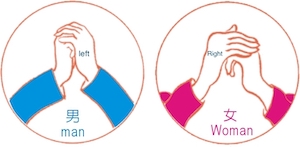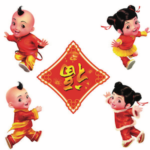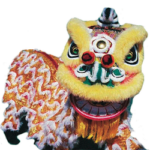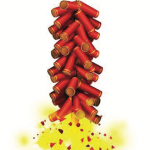February 14th, SATURDAY,2026
17th Annual Chinese New Year Festival
Time: 10:30am-5:30pm, Saturday
Luther Jackson Middle School - 3020 Gallows Rd., Falls Church, VA 22042
Children (under 6) Free, Children (6-12) $2, Adults $5.
Click here to buy ticket online with 5% discount.
点击 这里购票 5% 折扣
Chinese New Year Festival in the Washington DC metropolitan area is sponsored by Asian Community Service Center (ACSC) annually. ACSC is a volunteer-based independent non-profit organization in DC area (and anyone is welcome to join ACSC). Currently, ACSC volunteers are mostly Chinese Americans who have been living in the United States for many years. We hope that our children will keep in their memory the cultural roots and traditions of the Chinese New Year when they grow up. In addition, DC area is a culturally diverse community, and various celebrations from other cultures have motivated us to share the essence of Chinese culture with the local community. We would like children from all over the world to have an opportunity to experience the unique aspects of Chinese culture and traditions of five thousand years. Every year we promote a theme around the traditional Chinese values. The Chinese New Year is also the time for the entire family to gather together and give each other blessings to start a new year. We sincerely extend our invitation to all DC area residents to celebrate the Chinese New Year with us, to return to the traditions and to embrace a bright future.
Chinese New Year Festival in Washington DC area is host by Asian Community Service Center (ACSC) annually. Usually it is one day in-door events with cultural performances including dragon and lion dances, delicious Asian foods, New Year Parade, Culture exhibition, Craft show, language, health and business booths, and children’s activities, among other attractions. We encourage you to wear Asian costume or your traditional costume to share with our community. The mission of our event is: Return to Tradition.
SPONSORSHIP
To become a sponsor, please download the application form:
Sponsor Application Form in PDF; Form in MSWord
NON-FOOD VENDOR APPLICATION (One Day)
| Booth Option | Description | Price |
|---|---|---|
| Art & Crafts - A | 8’x10’- bring your own table less than 6’ x 3’, 2 chairs | $200 |
| Art & Crafts - B | 14’x10’ - include 6’x3’ table, 2 chairs (can ask for 2 more) | $375 |
| Businesses - A | 8’x10’- bring your own table less than 6’ x 3’, 2 chairs | $250 |
| Businesses - B | 14’x10’ - include 6’x3’ table, 2 chairs (can ask for 2 more) | $450 |
| Community/ Nonprofits - A | 8’x10’- bring your own table less than 6’ x 3’, 2 chairs | $120 |
| Community/ Nonprofits - B | 14’x10’ - include 6’x3’ table, 2 chairs (can ask for 2 more) | $200 |
| Ads in event newspaper | 1/4page: $280; 1/8pg:$150; 1/16pg:$80;1/32pg:$45 |
To apply for the booth, please download the application form:
Non-Food Vendor Application Form in PDF; Form in MSWord
For details, please call Tiny at 571-336-6098, or email us at contact@AsianServiceCenter.org
Vendor Name:_______________________________ License ID: _________________
Food and Drinks Items and Price (ACSC reserves right to remove items if no listed)
________________________________________________________________________
Will you be grilling?____ Will you need electricity? _____ Volts: __ 110; ___ 220 Amps
Insurance and License. All food vendors must submit proof of the following:
l Food permit/license issued by Fairfax County Health Department.
l Certificate of $1 million insurance policy that names Chinese New Year Festival 2019 and Asian Community Service Center as insureds on the insurance certificate.
To apply for the booth, please download the application form:
Food Vendor Application Form in PDF; in MSWord
For details, please call Tiny at 571-336-6098, or email us at contact@AsianServiceCenter.org
FESTIVAL PERFORMERS
Welcome to share your performance with us. We accept all Asian traditional performance. Plesae send us your previous performance pictures and video if possible. Please download the application below and send back to us by email.
VOLUNTEERS APPLICATION
Welcome all age from 12 to adult to join our volunteers team. You can get community service hours for your volunteer work. You can apply now and we also need some volunteers before the event. Please download the application below and send back to us by email.
REGISTRATION FORMS
Please download all the application forms here
Sponsors Application Form in PDF
Sponsorship Contract in PDF; Form in MSWord
Non-Food Vendor Application Form in PDF; Form in MSWord
Food Vendor Application Form in PDF; in MSWord
Performers Application Form in PDF; in MSWord
Volunteers Application Form in PDF; in MSWord
For details, please call Tiny at 571-336-6098, or email us at contact@AsianServiceCenter.org
The New Year is not only a moment of reunion and celebration. As “The Analects of Confucius” states that “devote care to life’s end and pursue reverence for the ancestors; in this way, the virtue of the people will return to its fullness”, the New Year is also a time to practice prayer, pay respect for the ancestors and promote the traditional Chinese culture.
However, we are now in an era of change and turmoil. The technological development has indulged us in the virtual world through proliferation of smart phones and internet. People are obsessing with playing computer games instead of being close to nature, and even alienating the loved ones who love and care the most about us in the world. All kinds of the so-called absolute “freedom” also tend to make people forget their responsibilities and obligations to the society. Instead, people would rather focus on enjoying the momentary pleasure, thus undermining the values and vows in the family. The traditional notion of a young man “be respectful to his parents and other elders, be careful and trustworthy, be compassionate to others, and be close to someone with virtue” is no longer observed.
The mission of Chinese New Year Festival is to bring our community to “Return to Tradition”.

Traditional Greeting Pose
Since ancient times, the traditional gestures for expressing the New Year greeting are distinguished between men and women. The standard man’s stance is to hold his right hand tight and wrap it around with his left hand. Because the right hand is typically the hand to attack in a fight, wrapping it around with the left hand is to show kindness. The opposite is true for women, where the right hand wraps around the left hand, but women do not hold a fist of their left hands but rather only press them a little. This is in line with the ancient tradition of “male left and female right.”

The Legend of “Nian”
The Lunar Festival, or Chinese New Year, is the most important festival for Chinese people.
Legend has it that in ancient times, there was a monster called “Nian” (“year”) that would come out to eat people and animals on the eve of every New Year. To avoid the monster’s attack, people would flee to the depth of the mountains and call this day “Nian Guan” (meaning “the Pass of Nian”).
On one New Year’s Eve, there came an old beggar in Peach Blossom Village, where an old lady gave him some food and asked him to hide himself in the mountain to avoid the monster Nian. The old man promised that he could drive the monster away as long as he was put up for the night at the old lady’s home. Being unable to persuade the old man into hiding in the mountain, the old lady went alone.

The Red Packets (“HongBao” or “LiShi”)
On the stroke of midnight on New Year’s Day, parents will give red packets containing money gifts to their siblings as a form of blessing; the children then place the red packet underneath their pillows when they sleep.
Red packets are every child’s delight at Chinese New Year! The tradition of giving gifts in Chinese culture is not the same as practiced in European or “western” culture. The way in which this is done in the West would be by putting money in a card, or indeed, giving a gift voucher. The Chinese give money inside red envelopes which are decorated with lucky symbols or Chinese characters. These are known as “LiShi” or “HungBao”.
At Chinese New Year these are given by married couples to children/unmarried people. The red is used as the most auspicious color, while the decoration may have a blessing or good wish. The symbolic giving of the money represents a wish for fortune and wealth in the coming year. The money may also be used to pay off debt, thus allowing a financial clean slate in the new year.
This tradition is derived from the legend of “Nian”, where the children are given red papers to protect themselves if they ever come into contact with the beast.

Dragon Dance
The Dragon Dance, also called “Dragon Lantern Dance”, is a traditional performance of the Han people. Dragon Dance is performed in almost all special festivals.
Dragon Dance originated from Han Dynasty and the tradition never fades. It was originally performed to please the ancestors and to plead for enough rain for crops, it has gradually become a cultural activity. Since the Tang and Sung Dynasty, Dragon Dance can be seen in every festival.
A fairy tale tells the legend: One day, the Dragon King felt some terrible pain around his waist. After consuming all medication he could find, the pain persisted. Without any other option, he turned into human form and sought for doctor’s
advice. After the inspection, the doctor claimed, “You are not a human.” Realizing that he couldn’t pretend anymore, the Dragon King turned into his original form. The doctor helped removed a scolopendrid from his waist and applied medication on the wound. The Dragon King felt relieve immediately. In appreciation to the doctor’s help, the Dragon King said this to the doctor, “Dance in
gears in the form of a dragon and you shall be granted with smooth weather and great harvests.” The news quickly spread and people began to dance in gears built to the form of a dragon to plead for rain in drought seasons.
Rules for Dragon Dance include: Green for spring season, Red for summer, White for autumn and Black for winter.

Lion Dance
The most spectacular event of the Chinese New Year festivities must surely be the Lion Dance. Lion dances take place throughout the first few days of the Chinese New Year, and bring good luck to the households or businesses which they visit. The Lion Dance itself is performed by two dancers, one at the head and one at the tail of the lion. To enhance the ‘life’ of the lion, the eyelids, mouth and ears of the Lion’s head all move.
The dance is accompanied by loud music played on large drum, gong and cymbals. The use of firecrackers, drums, gongs and cymbals are related to the role of the lion
The dramatic climax of the Lion Dance is the “CaiQing” or ‘Picking the Green’. The green here refers to vegetable leaves which are tied to a piece of string which also has a red packet attached containing money. The string is hung above the door of the house or business, and the lion ‘eats’ both leaves and in dispelling evil bringing good luck – evil being afraid of loud noise

New Year’s Eve Dinner
The New Year’s Eve dinner is the most important dinner for Chinese. Normally this is the family reunion dinner, especially for those with family member away from home. In the New Year’s Eve dinner, normally sh will be served. Dumplings are the most important disk in northern china. These two dishes mean prosperous. Other disks are depending on personal preference. The majority of Chinese will have New Year’s Eve dinner at home instead of restaurant.
Guarding the Night
Children stay awake during the night of Chinese New Year Eve to pray for good health of their parents.
This is also derived from the legend of “Nian”, where members of the family stayed awake on the night of Chinese New Year Eve to guard the family from the beast.
Chinese people will greet each other with pleasant words like ‘Happy New Year’, ‘Good Fortune’, etc during Chinese New Year. The phrase “GongXi” (or “Gong Hei” in Cantonese) means ‘Congratulations’, derived from the legend of “Nian”, congratulating each other to have escaped the harm of the beast.
Fireworks are used to drive away the evil in China. Right after the 12:00am of the New Year’s Eve, reworks will be launched to celebrate the coming of the New Year as well as driven away the evil. It is believed that the person who launched the rst Fireworks in the New Year will get good luck.
Tel: 571-336-6098
Fax: 703-763-2340
Email: contact@AsianServiceCenter.org
Facebook:  facebook.com/chinesenewyearcelebration
facebook.com/chinesenewyearcelebration
Admission: Children (under 6) Free, Children (6-12) $2, Adults $5
Where: Luther Jackson Middle School
3020 Gallows Road
Falls Church, VA 22042